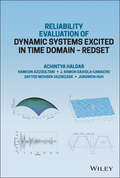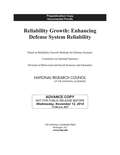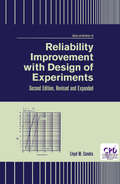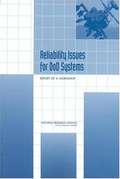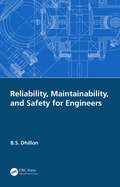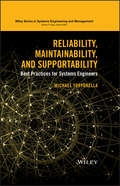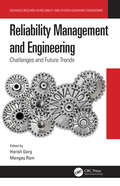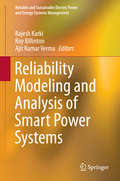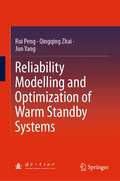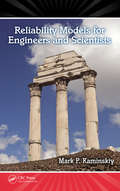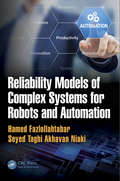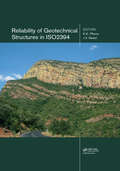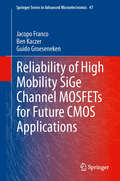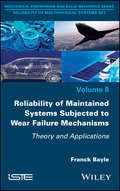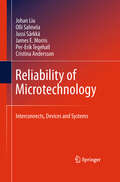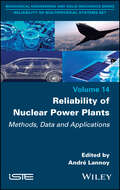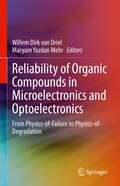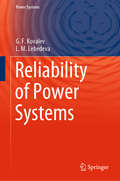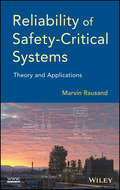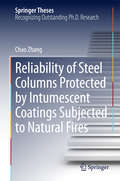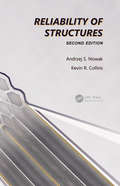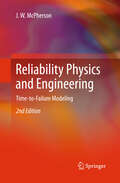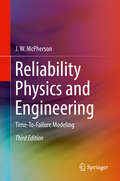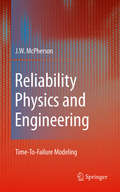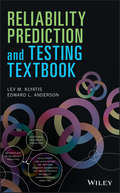- Table View
- List View
Reliability Evaluation of Dynamic Systems Excited in Time Domain - Redset: Alternative to Random Vibration and Simulation
by Achintya Haldar Hamoon Azizsoltani J. Ramon Gaxiola-Camacho Sayyed Mohsen Vazirizade Jungwon HuhRELIABILITY EVALUATION OF DYNAMIC SYSTEMS EXCITED IN TIME DOMAIN – REDSET Multi-disciplinary approach to structural reliability analysis for dynamic loadings offering a practical alternative to the random vibration theory and simulation Reliability Evaluation of Dynamic Systems Excited in Time Domain – REDSET is a multidisciplinary concept that enables readers to estimate the underlying risk that could not be solved in the past. The major hurdle was that the required limit state functions (LSFs) are implicit in nature and the lack of progress in the reliability evaluation methods for this class of problems. The most sophisticated deterministic analysis requires that the dynamic loadings must be applied in the time domain. To satisfy these requirements, REDSET is developed. Different types and forms of dynamic loadings including seismic, wind-induced wave, and thermomechanical loading in the form of heating and cooling of solder balls used in computer chips are considered to validate REDSET. Time domain representations and the uncertainty quantification procedures including the use of multiple time histories are proposed and demonstrated for all these dynamic loadings. Both onshore and offshore structures are used for validation. The potential of REDSET is demonstrated for implementing the Performance Based Seismic Design (PBSD) concept now under development in the United States. For wider multidisciplinary applications, structures are represented by finite elements to capture different types of nonlinearity more appropriately. Any computer program capable of conducting nonlinear time domain dynamic analysis can be used, and the underlying risk can be estimated with the help of several dozens or hundreds of deterministic finite element analyses, providing an alternative to the simulation approach. To aid comprehension of REDSET, numerous illustrative examples and solution strategies are presented in each chapter. Written by award-winning thought leaders from academia and professional practice, the following sample topics are included: Fundamentals of reliability assessment including set theory, modeling of uncertainty, the risk-based engineering design concept, and the evolution of reliability assessment methods Implicit performance or limit state functions are expressed explicitly by the extensively modified response surface method with several new experimental designs Uncertainty quantification procedures with multiple time histories for different dynamic loadings, illustrated with examples The underlying risk can be estimated using any computer program representing structures by finite elements with only few deterministic analyses REDSET is demonstrated to be an alternative to the classical random vibration concept and the basic simulation procedure for risk estimation purposes REDSET changes the current engineering design paradigm. Instead of conducting one deterministic analysis, a design can be made more dynamic load tolerant, resilient, and sustainable with the help of a few additional deterministic analyses This book describing REDSET is expected to complement two other books published by Wiley and authored by Haldar and Mahadevan: Probability, Reliability and Statistical Methods in Engineering Design and Reliability Assessment Using Stochastic Finite Element Analysis. The book is perfect to use as a supplementary resource for upper-level undergraduate and graduate level courses on reliability and risk-based design.
Reliability Growth: Enhancing Defense System Reliability
by Panel on Reliability Growth Methods for Defense SystemsA high percentage of defense systems fail to meet their reliability requirements. This is a serious problem for the U. S. Department of Defense (DOD), as well as the nation. Those systems are not only less likely to successfully carry out their intended missions, but they also could endanger the lives of the operators. Furthermore, reliability failures discovered after deployment can result in costly and strategic delays and the need for expensive redesign, which often limits the tactical situations in which the system can be used. Finally, systems that fail to meet their reliability requirements are much more likely to need additional scheduled and unscheduled maintenance and to need more spare parts and possibly replacement systems, all of which can substantially increase the life-cycle costs of a system. Beginning in 2008, DOD undertook a concerted effort to raise the priority of reliability through greater use of design for reliability techniques, reliability growth testing, and formal reliability growth modeling, by both the contractors and DOD units. To this end, handbooks, guidances, and formal memoranda were revised or newly issued to reduce the frequency of reliability deficiencies for defense systems in operational testing and the effects of those deficiencies. "Reliability Growth" evaluates these recent changes and, more generally, assesses how current DOD principles and practices could be modified to increase the likelihood that defense systems will satisfy their reliability requirements. This report examines changes to the reliability requirements for proposed systems; defines modern design and testing for reliability; discusses the contractor's role in reliability testing; and summarizes the current state of formal reliability growth modeling. The recommendations of "Reliability Growth" will improve the reliability of defense systems and protect the health of the valuable personnel who operate them.
Reliability Improvement with Design of Experiment, Second Edition, (Quality and Reliability)
by Lloyd CondraA guide to implementing and operating a practical reliability program using carefully designed experiments to provide information quickly, efficiently and cost effectively. It emphasizes real world solutions to daily problems. The second edition contains a special expanded section demonstrating how to combine accelerated testing with design of experiments for immediate improvement.
Reliability Issues for DoD Systems: REPORT OF A WORKSHOP
by Committee on National StatisticsA report on Reliability Issues for DoD Systems
Reliability, Maintainability, and Safety for Engineers
by B.S. DhillonTo meet the needs of today, engineered products and systems are an important element of the world economy, and each year billions of dollars are spent to develop, manufacture, operate, and maintain various types of products and systems around the globe. This book integrates and combines three of those topics to meet today’s needs for the engineers working in these fields. This book provides a single volume that considers reliability, maintainability, and safety when designing new products and systems. Examples along with their solutions are placed at the end of each chapter to test readers’ comprehension. The book is written in a manner that readers do not need any previous knowledge of the subject, and many references are provided. This book is also useful to many people, including design engineers, system engineers, reliability specialists, safety professionals, maintainability engineers, engineering administrators, graduate and senior undergraduate students, researchers, and instructors.
Reliability, Maintainability, and Supportability
by Michael TortorellaFocuses on the core systems engineering tasks of writing, managing, and tracking requirements for reliability, maintainability, and supportability that are most likely to satisfy customers and lead to success for suppliers This book helps systems engineers lead the development of systems and services whose reliability, maintainability, and supportability meet and exceed the expectations of their customers and promote success and profit for their suppliers. This book is organized into three major parts: reliability, maintainability, and supportability engineering. Within each part, there is material on requirements development, quantitative modelling, statistical analysis, and best practices in each of these areas. Heavy emphasis is placed on correct use of language. The author discusses the use of various sustainability engineering methods and techniques in crafting requirements that are focused on the customers' needs, unambiguous, easily understood by the requirements' stakeholders, and verifiable. Part of each major division of the book is devoted to statistical analyses needed to determine when requirements are being met by systems operating in customer environments. To further support systems engineers in writing, analyzing, and interpreting sustainability requirements, this book also Contains "Language Tips" to help systems engineers learn the different languages spoken by specialists and non-specialists in the sustainability disciplines Provides exercises in each chapter, allowing the reader to try out some of the ideas and procedures presented in the chapter Delivers end-of-chapter summaries of the current reliability, maintainability, and supportability engineering best practices for systems engineers Reliability, Maintainability, and Supportability is a reference for systems engineers and graduate students hoping to learn how to effectively determine and develop appropriate requirements so that designers may fulfil the intent of the customer.
Reliability Management and Engineering: Challenges and Future Trends (Advanced Research in Reliability and System Assurance Engineering)
by Harish Garg Mangey RamReliability technology plays an important role in the present era of industrial growth, optimal efficiency, and reducing hazards. This book provides insights into current advances and developments in reliability engineering, and the research presented is spread across all branches. It discusses interdisciplinary solutions to complex problems using different approaches to save money, time, and manpower. It presents methodologies of coping with uncertainty in reliability optimization through the usage of various techniques such as soft computing, fuzzy optimization, uncertainty, and maintenance scheduling. Case studies and real-world examples are presented along with applications that can be used in practice. This book will be useful to researchers, academicians, and practitioners working in the area of reliability and systems assurance engineering. Provides current advances and developments across different branches of engineering. Reviews and analyses case studies and real-world examples. Presents applications to be used in practice. Includes numerous examples to illustrate theoretical results.
Reliability Modeling and Analysis of Smart Power Systems
by Rajesh Karki Roy Billinton Ajit Kumar VermaThe volume presents the research work in understanding, modeling and quantifying the risks associated with different ways of implementing smart grid technology in power systems in order to plan and operate a modern power system with an acceptable level of reliability. Power systems throughout the world are undergoing significant changes creating new challenges to system planning and operation in order to provide reliable and efficient use of electrical energy. The appropriate use of smart grid technology is an important drive in mitigating these problems and requires considerable research activities, some of which (by researchers from academia and industry) are included in this volume: the reliability appraisal of smart grid technologies and their applications, micro-grids, assessment of plug-in hybrid vehicles and the system effects, smart system protection and reliability evaluation, demand response and smart maintenance of power system equipment.
Reliability Modelling and Optimization of Warm Standby Systems
by Rui Peng Qingqing Zhai Jun YangThis book introduces the reliability modelling and optimization of warm standby systems. Warm standby is an attractive redundancy technique, as it consumes less energy than hot standby and switches into the active state faster than cold standby. Since a warm standby component experiences different failure rates in the standby state and active state, the reliability evaluation is challenging and the existing works are only restricted to very special cases. By adapting the decision diagrams, this book proposes the methodology to evaluate the reliability of different types of warm standby systems and studies the reliability optimization. Compared with existing works, the proposed methods allow the system to have an arbitrary number of components and allow the failure time distribution of components to observe arbitrary distributions. From this book, the readers can not only learn how to evaluate and optimize the reliability of warm standby systems but also use the methods to study the reliability of other complex systems.
Reliability Models for Engineers and Scientists
by Mark P. KaminskiyA discussion of the basic reliability concepts and models, Reliability Models for Engineers and Scientists demystifies modern mathematical reliability models. Requiring very little mathematical background on the reader's part, this concise book introduces the models by focusing on their physical meaning and the supporting data; it then goes on to p
Reliability Models of Complex Systems for Robots and Automation
by Hamed Fazlollahtabar Seyed Taghi NiakiAvailability of a system is a crucial factor for planning and optimization. The concept is more challenging for modern systems such as robots and autonomous systems consisting of a complex configuration of components. As complex systems have become global and essential in today’s society, their reliable design and the determination of their availability have turned into a very important task for managers and engineers. <P><P>Reliability Models of Complex Systems for Robots and Automation offers different models and approaches for reliability evaluation and optimization of a complex autonomous system. Comprehensive fault tree analysis on the critical components of industrial robots and its integration with the reliability block diagram approach is designed in order to investigate the robot system reliability. The cost and hazard decision tree are integrated for the first time in an approach to evaluate the reliability of a complex system. <li> Considers a complex production system composing of several autonomous robots <li> Develops binary state reliability evaluation model for a complex system <li> Introduces new concepts of hazard decision tree <li> Proposes fault tree and reliability block diagram for complex robotic systems <li> Develops stochastic process based reliability evaluation and optimization models <P><P>Today’s competitive world with increasing customer demands for highly reliable products makes reliability engineering a more challenging task. Reliability analysis is one of the main tools to ensure agreed delivery deadlines which in turn maintains certainty in real tangible factors such as customer goodwill and company reputation.
Reliability of Geotechnical Structures in ISO2394
by K.K. Phoon and J.V. RetiefThe latest 4th edition of the international standard on the principles of reliability for load bearing structures (ISO2394:2015) includes a new Annex D dedicated to the reliability of geotechnical structures. The emphasis in Annex D is to identify and characterize critical elements of the geotechnical reliability-based design process. This book contains a wealth of data and information to assist geotechnical engineers with the implementation of semi-probabilistic or full probabilistic design approaches within the context of established geotechnical knowledge, principles, and experience. The introduction to the book presents an overview on how reliability can play a complementary role within prevailing norms in geotechnical practice to address situations where some measured data and/or past experience exist for limited site-specifi c data to be supplemented by both objective regional data and subjective judgment derived from comparable sites elsewhere. The principles of reliability as presented in ISO2394:2015 provides the common basis for harmonization of structural and geotechnical design. The balance of the chapters describes the uncertainty representation of geotechnical design parameters, the statistical characterization of multivariate geotechnical data and model factors, semi-probabilistic and direct probability-based design methods in accordance to the outline of Annex D. This book elaborates and reinforces the goal of Annex D to advance geotechnical reliability-based design with geotechnical needs at the forefront while complying with the general principles of reliability given by ISO2394:2015. It serves as a supplementary reference to Annex D and it is a must-read for designing geotechnical structures in compliance with ISO2394:2015.
Reliability of High Mobility SiGe Channel MOSFETs for Future CMOS Applications
by Jacopo Franco Ben Kaczer Guido GroesenekenDue to the ever increasing electric fields in scaled CMOS devices, reliability is becoming a showstopper for further scaled technology nodes. Although several groups have already demonstrated functional Si channel devices with aggressively scaled Equivalent Oxide Thickness (EOT) down to 5Å, a 10 year reliable device operation cannot be guaranteed anymore due to severe Negative Bias Temperature Instability. This book focuses on the reliability of the novel (Si)Ge channel quantum well pMOSFET technology. This technology is being considered for possible implementation in next CMOS technology nodes, thanks to its benefit in terms of carrier mobility and device threshold voltage tuning. We observe that it also opens a degree of freedom for device reliability optimization. By properly tuning the device gate stack, sufficiently reliable ultra-thin EOT devices with a 10 years lifetime at operating conditions are demonstrated. The extensive experimental datasets collected on a variety of processed 300mm wafers and presented here show the reliability improvement to be process - and architecture-independent and, as such, readily transferable to advanced device architectures as Tri-Gate (finFET) devices. We propose a physical model to understand the intrinsically superior reliability of the MOS system consisting of a Ge-based channel and a SiO2/HfO2 dielectric stack. The improved reliability properties here discussed strongly support (Si)Ge technology as a clear frontrunner for future CMOS technology nodes.
Reliability of Maintained Systems Subjected to Wear Failure Mechanisms: Theory and Applications
by Franck BayleToday, the reliability of systems has become a major issue in most industrial applications. The theoretical approach to estimating reliability was largely developed in the 1960s for maintenance-free systems, and more recently, in the late 1990s, it was developed for maintenance-based systems. Customers’ expectations concerning reliability (as well as maintenance, safety, etc.) are growing ever more demanding over the generations of systems. However, the theoretical methods used to handle the systems are not suitable when aging mechanisms are present. This book proposes a theoretical approach to estimate all of these quantities correctly. In addition to the theoretical aspect, it details a number of issues that any industrial system will meet sooner or later, whether due to design flaws, the batch of components, manufacturing problems or new technologies that result in the aging of mechanisms during their operational use.
Reliability of Microtechnology
by Olli Salmela Cristina Andersson Jussi Sarkka Per-Erik Tegehall James E. Morris Johan LiuReliability of Microtechnology discusses the reliability of microtechnology products from the bottom up, beginning with devices and extending to systems. The book's focus includes but is not limited to reliability issues of interconnects, the methodology of reliability concepts and general failure mechanisms. Specific failure modes in solder and conductive adhesives are discussed at great length. Coverage of accelerated testing, component and system level reliability, and reliability design for manufacturability are also described in detail. The book also includes exercises and detailed solutions at the end of each chapter.
Reliability of Nuclear Power Plants: Methods, Data and Applications
by Andr 233 LannoySince the 1970s, the field of industrial reliability has evolved significantly, in part due to the design and early operation of the first generation nuclear power plants. Indeed, the needs of this sector have led to the development of specific and innovative reliability methods, which have since been taken up and adapted by other industrial sectors, leading to the development of the management of uncertainties and Health and Usage Monitoring Systems. In this industry, reliability assessment approaches have matured. There are now methods, data and tools available that can be used with confidence for many industrial applications. The purpose of this book is to present and illustrate them with real study cases.The book addresses the evolution of reliability methods, experience feedback and expertise (as data is essential for estimating reliability), the reliability of socio-technical systems and probabilistic safety assessments, the structural reliability and probabilistic models in mechanics, the reliability of equipment and the impact of maintenance on their behavior, human and organizational factors and the impact of big data on reliability. Finally, some R&D perspectives that can be developed in the future are presented. Written by several engineers, statisticians and human and organizational factors specialists in the nuclear sector, this book is intended for all those who are faced with a reliability assessment of their installations or equipment: decision-makers, engineers, designers, operation or maintenance engineers, project managers, human and organizational factors specialists, experts and regulatory authority inspectors, teachers, researchers and doctoral students.
Reliability of Organic Compounds in Microelectronics and Optoelectronics: From Physics-of-Failure to Physics-of-Degradation
by Willem Dirk van Driel Maryam Yazdan MehrThis book aims to provide a comprehensive reference into the critical subject of failure and degradation in organic materials, used in optoelectronics and microelectronics systems and devices. Readers in different industrial sectors, including microelectronics, automotive, lighting, oil/gas, and petrochemical will benefit from this book. Several case studies and examples are discussed, which readers will find useful to assess and mitigate similar failure cases. More importantly, this book presents methodologies and useful approaches in analyzing a failure and in relating a failure to the reliability of materials and systems.
Reliability of Power Systems (Power Systems)
by G.F. Kovalev L.M. LebedevaThis book presents essential methods and tools for research into the reliability of energy systems. It describes in detail the content setting, formalisation, and use of algorithms for assessing the reliability of modern, large, and complex electric power systems. The book uses a wealth of tables and illustrations to represent results and source information in a clear manner. It discusses the main operating conditions which affect the reliability of electric power systems, and describes corresponding computing tools which can help solve issues as they arise. Further, all methodologies presented here are demonstrated in numerical examples. Though primarily intended for researchers and practitioners in the field of electric power systems, the book will also benefit general readers interested in this area.
Reliability of Safety-Critical Systems
by Marvin RausandPresents the theory and methodology for reliability assessments of safety-critical functions through examples from a wide range of applications Reliability of Safety-Critical Systems: Theory and Applications provides a comprehensive introduction to reliability assessments of safety-related systems based on electrical, electronic, and programmable electronic (E/E/PE) technology. With a focus on the design and development phases of safety-critical systems, the book presents theory and methods required to document compliance with IEC 61508 and the associated sector-specific standards. Combining theory and practical applications, Reliability of Safety-Critical Systems: Theory and Applications implements key safety-related strategies and methods to meet quantitative safety integrity requirements. In addition, the book details a variety of reliability analysis methods that are needed during all stages of a safety-critical system, beginning with specification and design and advancing to operations, maintenance, and modification control. The key categories of safety life-cycle phases are featured, including strategies for the allocation of reliability performance requirements; assessment methods in relation to design; and reliability quantification in relation to operation and maintenance. Issues and benefits that arise from complex modern technology developments are featured, as well as: Real-world examples from large industry facilities with major accident potential and products owned by the general public such as cars and toolsPlentiful worked examples throughout that provide readers with a deeper understanding of the core concepts and aid in the analysis and solution of common issues when assessing all facets of safety-critical systemsApproaches that work on a wide scope of applications and can be applied to the analysis of any safety-critical systemA brief appendix of probability theory for reference With an emphasis on how safety-critical functions are introduced into systems and facilities to prevent or mitigate the impact of an accident, this book is an excellent guide for professionals, consultants, and operators of safety-critical systems who carry out practical, risk, and reliability assessments of safety-critical systems. Reliability of Safety-Critical Systems: Theory and Applications is also a useful textbook for courses in reliability assessment of safety-critical systems and reliability engineering at the graduate-level, as well as for consulting companies offering short courses in reliability assessment of safety-critical systems.
Reliability of Steel Columns Protected by Intumescent Coatings Subjected to Natural Fires
by Chao ZhangThis thesis studied the effect of aging of intumescent coatings (ICs) on the reliability of protected steel columns in fire condition and developed a probabilistic approach to assess the service life of ICs applied on steel columns. In the study, Monte Carlo simulations were conducted to obtain the reliability index or failure probability of steel columns protected by ICs subjected to compartment fires. The effect of aging of intumescent coatings on the failure probability of protected steel columns was investigated by using variable insulation property of intumescent coatings in the simulation. The test data on aging effect on insulation property of intumescent coatings from literature was used. Based on the reliability analysis, a probabilistic approach is given to determine the service life of intumescent coatings for steel columns. In that approach, the failure probability of the protected steel columns is compared with the target probability of the structural fire design. The approach can also be used for probabilistic analysis of steel columns protected by conventional inert fire protection materials.
Reliability of Structures
by Andrzej S. Nowak Kevin R. CollinsReliability of Structures enables both students and practising engineers to appreciate how to value and handle reliability as an important dimension of structural design. It discusses the concepts of limit states and limit state functions, and presents methodologies for calculating reliability indices and calibrating partial safety factors. It also
Reliability Physics and Engineering: Time-To-Failure Modeling, 2nd Edition
by J. W. Mcpherson"Reliability Physics and Engineering" provides critically important information for designing and building reliable cost-effective products. The textbook contains numerous example problems with solutions. Included at the end of each chapter are exercise problems and answers. "Reliability Physics and Engineering" is a useful resource for students, engineers, and materials scientists.<P><P> Includes eight new appendices plus three new chapters on screening, heat generation and dissipation, and sampling plans and confidence intervals
Reliability Physics and Engineering: Time-To-Failure Modeling
by J. W. McPhersonThis third edition textbook provides the basics of reliability physics and engineering that are needed by electrical engineers, mechanical engineers, civil engineers, biomedical engineers, materials scientists, and applied physicists to help them to build better devices/products. The information contained within should help all fields of engineering to develop better methodologies for: more reliable product designs, more reliable materials selections, and more reliable manufacturing processes— all of which should help to improve product reliability. A mathematics level through differential equations is needed. Also, a familiarity with the use of excel spreadsheets is assumed. Any needed statistical training and tools are contained within the text. While device failure is a statistical process (thus making statistics important), the emphasis of this book is clearly on the physics of failure and developing the reliability engineering tools required for product improvements during device-design and device-fabrication phases.
Reliability Physics and Engineering
by J. W. McphersonThis book provides the basic Reliability Physics and Engineering tools that are needed by Electrical Engineers, Mechanical Engineers, Materials Scientists, and Applied Physicists to build better products. The material includes information for engineers to develop better methodologies for producing reliable product designs and materials selections to improve product reliability. Important statistical training and tools are contained within the text. The author emphasizes the physics of failure and the development of reliability engineering models for failure. The beginning of the book concentrates on device/materials degradation and the development of the critically important time-to-failure models. Since time-to-failure is a statistical process, the needed statistical tools are presented next along with failure-rate modeling. Following that the use of accelerated testing and the modeling of the acceleration factors are presented. The next section focuses on the effective use of these acceleration factors, during initial product-level testing and operation, in order to reduce the expected device failure rate in the field. The important time-to-failure models are presented next for Electrical Engineering applications. Likewise, the next section addresses important time-to-failure models for Mechanical Engineering applications. The final chapters provide both Electrical and Mechanical Engineers with design help specifically, conversion of dynamic/transient stresses into equivalent static forms, establishing aggressive but safe design rules, and the need to look very closely at design and process interactions.
Reliability Prediction and Testing Textbook
by Lev M. Klyatis Edward L. AndersonThis textbook reviews the methodologies of reliability prediction as currently used in industries such as electronics, automotive, aircraft, aerospace, off-highway, farm machinery, and others. It then discusses why these are not successful; and, presents methods developed by the authors for obtaining accurate information for successful prediction. The approach is founded on approaches that accurately duplicate the real world use of the product. Their approach is based on two fundamental components needed for successful reliability prediction; first, the methodology necessary; and, second, use of accelerated reliability and durability testing as a source of the necessary data. Applicable to all areas of engineering, this textbook details the newest techniques and tools to achieve successful reliabilityprediction and testing. It demonstrates practical examples of the implementation of the approaches described. This book is a tool for engineers, managers, researchers, in industry, teachers, and students. The reader will learn the importance of the interactions of the influencing factors and the interconnections of safety and human factors in product prediction and testing.
